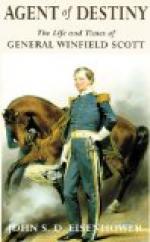Both of these streams were bridged on the road to Chippewa, the one over Street’s Creek being nearest to Scott, while that over the Chippewa was nearest to Riall. On the morning of the 5th General Brown had determined to make the attack, but the enemy, anticipating it, made the first forward movement, and there were a number of skirmishes. General Porter, whose command consisted of volunteers, militia, and friendly Indians, first engaged the British and drove them back through the woods. General Riall at this moment was seen advancing with the main body of his army, and the retreating troops rallied, attacking Porter furiously, and, despite his own coolness and gallantry, his troops gave way and fled. This was about four o’clock, and General Brown, being with Porter, saw the advance of the British force, and meeting General Scott, said to him, “The enemy is advancing.” General Brown then moved to the rear and ordered the advance of Ripley’s brigade. The British army was composed of the One Hundredth Regiment, under the Marquis of Tweedale, the First Royal Scots, under Lieutenant-Colonel Gordon, a portion of the Eighth or King’s Regiment, a detachment of the Royal Artillery, a detachment of the Royal Nineteenth Light Dragoons, and some Canadian militia and Indians. These were supported by a heavy battery of nine guns. Scott crossed the bridge under fire of this battery, losing a number of men. After crossing, the commands of Majors Henry Leavenworth and John McNeil, Jr., formed line in front opposite the center and left of the enemy. Major Thomas Sidney Jesup moved to the left and advanced to attack the enemy’s right. Towson’s battery was on the right, on the Chippewa road. Seeing that the British lines outflanked him, Scott ordered the movement of Jesup to the left. The battle now opened, Jesup holding in check the right wing of the enemy, his position in the wood concealing him from view. General Scott had now advanced to within eighty paces of the enemy, and ordering the left flank of McNeil’s battalion formed on the right so that it was oblique to the enemy’s charge and flanking him on the right. Scott called to McNeil’s command, which had no recruits in it: “The enemy say we are good at long shot, but can not stand the cold iron. I call upon the Eleventh to give the lie to that slander. Charge!” The charge was made at once, supported by a corresponding charge of Leavenworth and a flank fire from Towson’s battery. The British broke, and fled in great confusion.
In the meantime Major Jesup, commanding on the left, ordered his men to advance, which they did, driving the enemy into his intrenchments across the Chippewa. The British forces engaged were about twenty-one hundred men, and that of the Americans nineteen hundred. The British lost in killed, one hundred and thirty-eight; wounded, three hundred and nineteen; and missing, forty-six. The American loss was sixty killed, two hundred and forty-eight wounded, and nineteen missing.




